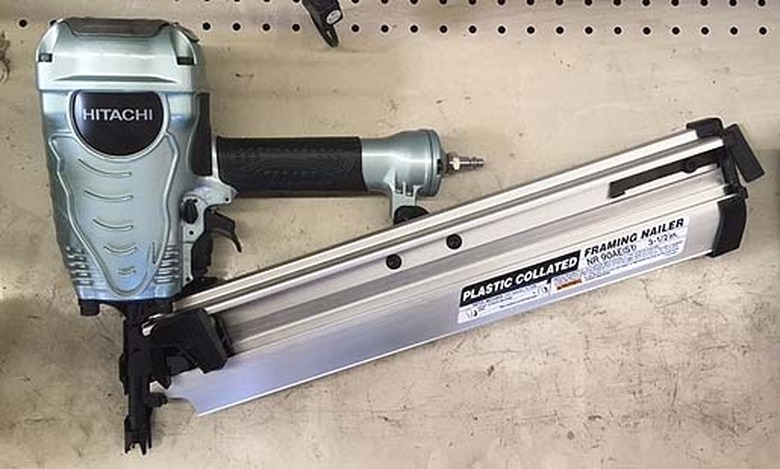21 Vs. 28 Degree Nailers
Whether you're framing or installing interior trim, a power nailer makes your job easier. If you're looking into purchasing a nailer, the angle between the head and the nail magazine is one of the factors to consider. This angle is somewhere between zero and 34 degrees, with angles of zero, 21 degrees and 28 and 33 degrees being most common. The main advantage of a steeper angle is that it allows you to use the tool in tighter places. This is more important when you're doing interior carpentry than when you're framing. Electric and battery-powered wire nailers shoot smaller nails than pneumatic framing nailers, and they are more likely to have a 28-degree magazine angle than a 21-degree one.
The Importance of Magazine Angle
The Importance of Magazine Angle
The magazine angle doesn't affect the angle at which the nail emerges from the head of the nailer. As long as you hold the head flush against the work surface, the nailer will drive it perpendicularly into the wood. The purpose of angling the magazine with respect to the head is almost exclusively to save space.
Power nailers that shoot brads and staples are often designed with a zero-degree magazine angle. This simple design is practical because brads and staples are thin, and you can fit a lot of them into a small space. Three-and-a-half-inch framing nails, on the other hand, are relatively fat, and the magazine needs to be longer to accommodate a reasonable number of them. Enter the 21-degree magazine angle, which reduces the horizontal extension of the magazine by about 15 percent.
Increasing the magazine angle to 28 degrees saves even more space, but it's challenging to design a drive mechanism that has enough power to drive full-size nails at such a steep angle. Consequently, the nails for a 28-degree nailer are usually smaller than those for 21-degree nailer. Moreover, except for one or two exceptions, they often have clipped heads, so that more of them can fit into the magazine.
Framers Need 21-Degree Guns
Framers Need 21-Degree Guns
The heavy-duty pneumatic nailers you find on construction sites usually have a 21-degree magazine angle. Framers need to drive full-size nails, and more important, they need the nails to have full heads. Many local codes prohibit clipped-head nails for framing. You might also find zero-degree nailers on construction sites, but these are usually lighter-duty tools for installing subfloors, siding and roof decking.
Steeper Angles Are Useful for Interior Trim Work
Steeper Angles Are Useful for Interior Trim Work
When you're installing interior trim, your gun doesn't need as much power, because it's driving finish nails or staples — not framing nails. Consequently, interior trim nailers often have steeper magazine angles, such as 28 and 34 degrees, to save space. You'll be thankful you have a that extra space when you have to use the nailer in tight corners. Battery-powered nailers–the ultimate in nailing convenience–aren't as powerful as pneumatic nailers, and they usually have a 28- or 34-degree magazine angle.
A Regional Thing?
A Regional Thing?
Magazine angle may partly be a matter of local preference. Contractors in Ontario, Canada, reported that, in 2014, www.contractortalk.com="" f40="" difference-between-degree-framing-nailers-155676="" "=""> nailers in that part of the world almost all had a 28- or 30-degree angle. One pro said in a 2014 contractor forum thread that he ordered a 21-degree nailer online by accident, and he couldn't resell it. On the other hand, American contractors in the same forum reported using 21-degree nailers almost exclusively. One carpenter in Auburn, New York, said he had never even seen a 28-degree nailer. Just as Robertson screws are the standard in Canada while Americans prefer Phillips screws, nail gun magazine angle preference may be something that changes when you cross the border.
The Ergonomic Choice
The Ergonomic Choice
One angle isn't necessarily any better than the other. The overall design and quality of the tool and its purpose are more important than the magazine angle. Because nails used in 21- and 28-degree nailers are not interchangeable, it's best to stick with one angle if you're supplying tools and nails for a crew. The main advantage of the 28-degree tool is that its compact design makes it easier to handle, especially in tight places. If you're a home handyman looking for an all-purpose tool that you can use for a variety of tasks, it's probably better to choose a 28-degree nailer than a 21-degree one.
